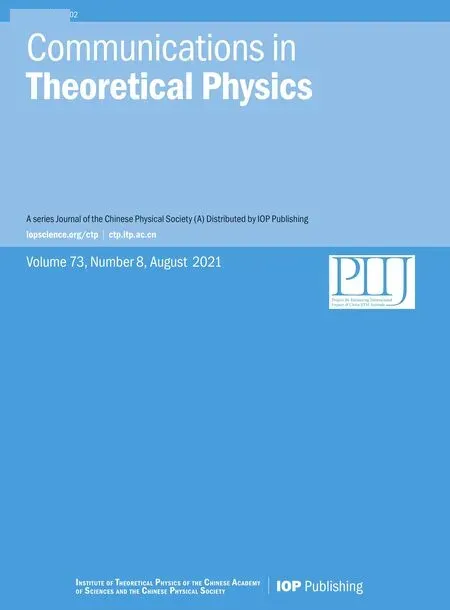Generalizations of the finite nonperiodic Toda lattice and its Darboux transformation
Jian Liand Chuanzhong Li
1 School of Mathematics and Statistics,Ningbo University,Ningbo,315211,China
2 College of Mathematics and Systems Science,Shandong University of Science and Technology,Qingdao,266590,China
Abstract In this paper,we construct Hamiltonian systems for 2N particles whose force depends on the distances between the particles.We obtain the generalized finite nonperiodic Toda equations via a symmetric group transformation.The solutions of the generalized Toda equations are derived using the tau functions.The relationship between the generalized nonperiodic Toda lattices and Lie algebras is then be discussed and the generalized Kac-van Moerbeke hierarchy is split into generalized Toda lattices,whose integrability and Darboux transformation are studied.
Keywords:Hamiltonian systems,Toda lattices,Darboux transformation,Lie algebra,Kac-van Moerbeke hierarchy
1.Introduction
Many mathematicians have made significant contributions to the Toda equations and have achieved many meaningful results.For example,in 1974,the complete integrability of the Toda lattice was demonstrated by Henon[1].A few years later,the nonlinear interactions in chains were well known[2].Also,in 1974,according to Flaschka[3,4],the Lax form was equivalent to the periodic Toda lattice:

where L is a tridiagonal matrix,B=(L)>0-(L)<0.Further,Moser showed the complete integrability of nonperiodic Toda lattices[5].With the development of integrable systems,the relationship was established between nonperiodic Toda lattices and their geometry and topology.Then,by considering the full Kostant–Toda hierarchy with real variables[6–8],it was shown that the regular solutions for the full Kostant–Toda lattices could be split into the algebra sln(R).In fact,in recent years,Kodama has made many outstanding achievements with nonperiodic Toda lattices[9–13].According to[14],any finite dimensional simple Lie algebra or Kac–Moody algebra can be split into generalized Toda lattices,and all these equations are integrable systems.There are many applications of two-dimensional Toda equations,including the inverse scattering method,the Hirota direct method,Darboux transformations[15,16],and so on[17–24].
This paper is arranged as follows.In section 2,we give the generalized Toda systems for2Nparticles,and the properties and the solutions of the generalized Toda equations are both discussed.In section 3,the relationship between the generalized nonperiodic Toda lattices and Lie algebras is studied.From the example given in this article,the generalized Kac-van Moerbeke hierarchy can be split into two Toda lattices.In section 4,Darboux transformations of the twodimensional generalized Toda equations are obtained.
2.Coupled Toda lattice
In this section,we consider2nparticles,whose force depends on the distances between the particles.For those particles,the coupled Hamiltoniansare given by


where the formal boundary conditions are given byatandIn fact,the equations(2.2)can be expressed in the Lax form,and we introduce a new set of variables,as follows:

Based on the above transformation(2.3),the generalized Toda equations(2.2)become


Thus,the systems(2.5)and(2.6)can be written as


For the2n-2 independent invariant functions,

where[]represents an integer operation andrepresents a binomial coefficient.From the calculation and transformation shown in(2.2),we obtain the relationship between the independent invariant functions and Hamiltonian

According to the properties of tridiagonal symmetric matrices[5],this has real and distinct eigenvalues.In fact,andqk+1-qktend to∞when t→±∞.Furthermore,it is easy to see thatand aktend to zero,sodegenerates into a diagonal matrixdiag(λ1,λ2,…,λn)

There are many methods to solve the the Toda lattice,such as QR-factorization[25],Gram-Schmidt orthogonalization[26],and so on.Based on the methods provided above and the generalized initial matricesthe factorization of the generalized initial matrices can be expressed as


wherer T(t)is the transpose ofr(t)From the decomposition of(2.13),the matrices r(t)andcan be obtained by the factorization of(2.12).
Definition 1.The tau functionsτj,(j=1,…,n-1)are defined by,

From the gauge transformation and the Gram-Schmidt method of orthonormalization,we then have

Therefore,with(2.14)and(2.4),we obtain the solutions


3.Generalized Toda lattice on Lie algebras
We first give the Lax equations of the generalized nonperiodic Toda lattice,which are connected with the Lie algebra g.The forms are as follows:

whereP(t),re the elements of g andare the projections ofwhich are given by




The integrability of the system can be ensured,because we give a specific example to illustrate it below.


In this way,we obtain all the even flows,which are called the generalized Kac-van Moerbeke hierarchy:

Consider the number of t2flows when j=1,


whereT(i)and(for i=1,2)are symmetric tridiagonal matrices,the specific forms of which are given as follows:

According to[29],we then have

from the structures ofT(i)and(i=1,2),the generalized Kac-van Moerbeke hierarchy for X2,can be split into generalized Toda lattices,and all of these equations are integrable systems.
4.Darboux transformation for the generalized Toda equations
We give two generalized affine Kac–Moody algebras(g1,,and the corresponding Toda equations are given as follows:



According to[30],any equation in(4.1)is integrable,and their Lax pairs can also be obtained.We consider the Lax pairs,based on the compatibility condition of the system(4.1),to be expressed as:

where



whereV=(Vjk)1≤j,k≤Nandare N×N block diagonal matrices.From(4.3),the integrability conditions of Lax pairs are then expressed as

AsJ,V,satisfy certain symmetry conditions,there are two real symmetric matrices K,that satisfy

and


Lemma 1.IfV(x,y)and(x,y)satisfy

thensatisfy

Lemma 2.

are real matrices,andK′,are symmetric matrices.


whereJ′,Q′andare given by lemma 2;whenλ0is real,φ′,are real solutions.
Proof.From

and

we can prove conclusions(1),(2).From

and

we have proved conclusion(3).According to the expressions ofJ′,′and(4)is obvious.□



Theorem 1.Let Φ,be the solutions of(4.3),sosatisfy

where



where

SinceG(λ),are the L-degree polynomials of λ,this can be also written as:

From(4.24),we have

AssumingG(λ),are given by(4.24),then theorem 1 is established.According to[24],we have


then

satisfies(4.28).From(4.25),we obtain

According to(4.28),the following expressions are established for all λ:

and the conclusion of theorem 1 is valid.In fact,

are obvious;what we need to prove is that

From the first two equations of(4.34),the following equations are true,

whenλ=0.On the other hand,from(4.30),we get

and the proof is complete.□
Remarks:
1.The equations and systems involved in this article are weakly coupled whenε=0;
2.The equations and systems involved in this article are strongly coupled whenε=1.
Acknowledgments
Chuanzhong Li is supported by the National Natural Science Foundation of China under Grant No.12 071 237 and by the K C Wong Magna Fund in Ningbo University.
ORCID iDs
 Communications in Theoretical Physics2021年8期
Communications in Theoretical Physics2021年8期
- Communications in Theoretical Physics的其它文章
- Quantum coherence and ground-state phase transition in a four-chain Bose–Hubbard model
- Padé approximations of quantized-vortex solutions of the Gross–Pitaevskii equation
- Modeling the roles of 14-3-3 σ and Wip1 in p53 dynamics and programmed cell death*
- Balanced biosynthesis and trigger threshold resulting in a double adder mechanism of cell size control
- MHD flow study of viscous fluid through a complex wavy curved surface due to biomimetic propulsion under porosity and second-order slip effects
- Effects of thermal fluctuations on the Kerr–Newman–NUT–AdS black hole
